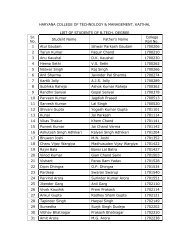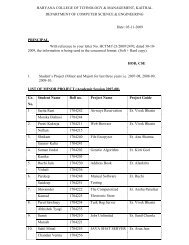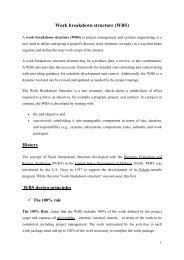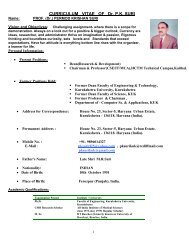- Page 1 and 2:
ADVANCED DATA STRUCTURE NOTES (MT
- Page 3 and 4:
LECTURE NOTES OF ADVANCED DATA STRU
- Page 5 and 6:
LECTURE NOTES OF ADVANCED DATA STRU
- Page 7 and 8:
LECTURE NOTES OF ADVANCED DATA STRU
- Page 9 and 10:
70 121 432 12 638 LECTURE NOTES OF
- Page 11 and 12:
LECTURE NOTES OF ADVANCED DATA STRU
- Page 13 and 14:
3 91 11 50 LECTURE NOTES OF ADVANCE
- Page 15 and 16:
LECTURE NOTES OF ADVANCED DATA STRU
- Page 17 and 18:
LECTURE NOTES OF ADVANCED DATA STRU
- Page 19 and 20:
LECTURE NOTES OF ADVANCED DATA STRU
- Page 21 and 22:
LECTURE NOTES OF ADVANCED DATA STRU
- Page 23 and 24:
LECTURE NOTES OF ADVANCED DATA STRU
- Page 25 and 26:
COLLISION LECTURE NOTES OF ADVANCED
- Page 27 and 28:
4. Rehashing LECTURE NOTES OF ADVAN
- Page 29 and 30:
LECTURE NOTES OF ADVANCED DATA STRU
- Page 31 and 32:
LECTURE NOTES OF ADVANCED DATA STRU
- Page 33 and 34:
LECTURE NOTES OF ADVANCED DATA STRU
- Page 35 and 36:
LECTURE NOTES OF ADVANCED DATA STRU
- Page 37 and 38:
LECTURE NOTES OF ADVANCED DATA STRU
- Page 39 and 40:
LECTURE NOTES OF ADVANCED DATA STRU
- Page 41 and 42:
LECTURE NOTES OF ADVANCED DATA STRU
- Page 43 and 44:
LECTURE NOTES OF ADVANCED DATA STRU
- Page 45 and 46:
LECTURE NOTES OF ADVANCED DATA STRU
- Page 47 and 48:
Instructions: LECTURE NOTES OF ADVA
- Page 49 and 50:
LECTURE NOTES OF ADVANCED DATA STRU
- Page 51 and 52:
LECTURE NOTES OF ADVANCED DATA STRU
- Page 53 and 54:
LECTURE NOTES OF ADVANCED DATA STRU
- Page 55 and 56:
LECTURE NOTES OF ADVANCED DATA STRU
- Page 57 and 58:
LECTURE NOTES OF ADVANCED DATA STRU
- Page 59 and 60:
LECTURE NOTES OF ADVANCED DATA STRU
- Page 61 and 62:
LECTURE NOTES OF ADVANCED DATA STRU
- Page 63 and 64:
LECTURE NOTES OF ADVANCED DATA STRU
- Page 65 and 66:
LECTURE NOTES OF ADVANCED DATA STRU
- Page 67 and 68:
LECTURE NOTES OF ADVANCED DATA STRU
- Page 69 and 70:
LECTURE NOTES OF ADVANCED DATA STRU
- Page 71 and 72:
LECTURE NOTES OF ADVANCED DATA STRU
- Page 73 and 74:
LECTURE NOTES OF ADVANCED DATA STRU
- Page 75 and 76:
LECTURE NOTES OF ADVANCED DATA STRU
- Page 77 and 78:
LECTURE NOTES OF ADVANCED DATA STRU
- Page 79 and 80:
LECTURE NOTES OF ADVANCED DATA STRU
- Page 81 and 82:
LECTURE NOTES OF ADVANCED DATA STRU
- Page 83 and 84:
LECTURE NOTES OF ADVANCED DATA STRU
- Page 85 and 86:
LECTURE NOTES OF ADVANCED DATA STRU
- Page 87 and 88:
LECTURE NOTES OF ADVANCED DATA STRU
- Page 89 and 90:
LECTURE NOTES OF ADVANCED DATA STRU
- Page 91 and 92:
LECTURE NOTES OF ADVANCED DATA STRU
- Page 93 and 94:
LECTURE NOTES OF ADVANCED DATA STRU
- Page 95 and 96:
LECTURE NOTES OF ADVANCED DATA STRU
- Page 97 and 98:
LECTURE NOTES OF ADVANCED DATA STRU
- Page 99 and 100:
DESTINATION DESTINATION LECTURE NOT
- Page 101 and 102:
LECTURE NOTES OF ADVANCED DATA STRU
- Page 103 and 104:
LECTURE NOTES OF ADVANCED DATA STRU
- Page 105 and 106:
LECTURE NOTES OF ADVANCED DATA STRU
- Page 107 and 108:
LECTURE NOTES OF ADVANCED DATA STRU
- Page 109 and 110:
LECTURE NOTES OF ADVANCED DATA STRU
- Page 111 and 112:
Algorithm LECTURE NOTES OF ADVANCED
- Page 113 and 114:
LECTURE NOTES OF ADVANCED DATA STRU
- Page 115 and 116:
LECTURE NOTES OF ADVANCED DATA STRU
- Page 117 and 118:
LECTURE NOTES OF ADVANCED DATA STRU
- Page 119 and 120:
LECTURE NOTES OF ADVANCED DATA STRU
- Page 121 and 122:
LECTURE NOTES OF ADVANCED DATA STRU
- Page 123 and 124:
LECTURE NOTES OF ADVANCED DATA STRU
- Page 125 and 126:
LECTURE NOTES OF ADVANCED DATA STRU
- Page 127 and 128:
LECTURE NOTES OF ADVANCED DATA STRU
- Page 129 and 130:
LECTURE NOTES OF ADVANCED DATA STRU
- Page 131 and 132:
LECTURE NOTES OF ADVANCED DATA STRU
- Page 133 and 134:
LECTURE NOTES OF ADVANCED DATA STRU
- Page 135 and 136:
LECTURE NOTES OF ADVANCED DATA STRU
- Page 137 and 138:
LECTURE NOTES OF ADVANCED DATA STRU
- Page 139 and 140:
LECTURE NOTES OF ADVANCED DATA STRU
- Page 141 and 142:
LECTURE NOTES OF ADVANCED DATA STRU
- Page 143 and 144:
queue LECTURE NOTES OF ADVANCED DAT
- Page 145 and 146:
LECTURE NOTES OF ADVANCED DATA STRU
- Page 147 and 148:
LECTURE NOTES OF ADVANCED DATA STRU
- Page 149 and 150:
LECTURE NOTES OF ADVANCED DATA STRU
- Page 151 and 152:
LECTURE NOTES OF ADVANCED DATA STRU
- Page 153 and 154:
SEARCHING LECTURE NOTES OF ADVANCED
- Page 155 and 156:
LECTURE NOTES OF ADVANCED DATA STRU
- Page 157 and 158: LECTURE NOTES OF ADVANCED DATA STRU
- Page 159 and 160: LECTURE NOTES OF ADVANCED DATA STRU
- Page 161 and 162: LECTURE NOTES OF ADVANCED DATA STRU
- Page 163 and 164: LECTURE NOTES OF ADVANCED DATA STRU
- Page 165 and 166: LECTURE NOTES OF ADVANCED DATA STRU
- Page 167 and 168: Step 2: Step 3 LECTURE NOTES OF ADV
- Page 169 and 170: LECTURE NOTES OF ADVANCED DATA STRU
- Page 171 and 172: LECTURE NOTES OF ADVANCED DATA STRU
- Page 173 and 174: LECTURE NOTES OF ADVANCED DATA STRU
- Page 175 and 176: LECTURE NOTES OF ADVANCED DATA STRU
- Page 177 and 178: a LECTURE NOTES OF ADVANCED DATA ST
- Page 179 and 180: LECTURE NOTES OF ADVANCED DATA STRU
- Page 181 and 182: LECTURE NOTES OF ADVANCED DATA STRU
- Page 183 and 184: D LECTURE NOTES OF ADVANCED DATA ST
- Page 185 and 186: LECTURE NOTES OF ADVANCED DATA STRU
- Page 187 and 188: 1 3 LECTURE NOTES OF ADVANCED DATA
- Page 189 and 190: LECTURE NOTES OF ADVANCED DATA STRU
- Page 191 and 192: LECTURE NOTES OF ADVANCED DATA STRU
- Page 193 and 194: LECTURE NOTES OF ADVANCED DATA STRU
- Page 195 and 196: LECTURE NOTES OF ADVANCED DATA STRU
- Page 197 and 198: LECTURE NOTES OF ADVANCED DATA STRU
- Page 199 and 200: LECTURE NOTES OF ADVANCED DATA STRU
- Page 201 and 202: LECTURE NOTES OF ADVANCED DATA STRU
- Page 203 and 204: LECTURE NOTES OF ADVANCED DATA STRU
- Page 205 and 206: LECTURE NOTES OF ADVANCED DATA STRU
- Page 207: LECTURE NOTES OF ADVANCED DATA STRU
- Page 211 and 212: LECTURE NOTES OF ADVANCED DATA STRU
- Page 213 and 214: LECTURE NOTES OF ADVANCED DATA STRU
- Page 215 and 216: LECTURE NOTES OF ADVANCED DATA STRU
- Page 217 and 218: LECTURE NOTES OF ADVANCED DATA STRU
- Page 219 and 220: LECTURE NOTES OF ADVANCED DATA STRU
- Page 221 and 222: Search LECTURE NOTES OF ADVANCED DA
- Page 223 and 224: LECTURE NOTES OF ADVANCED DATA STRU







